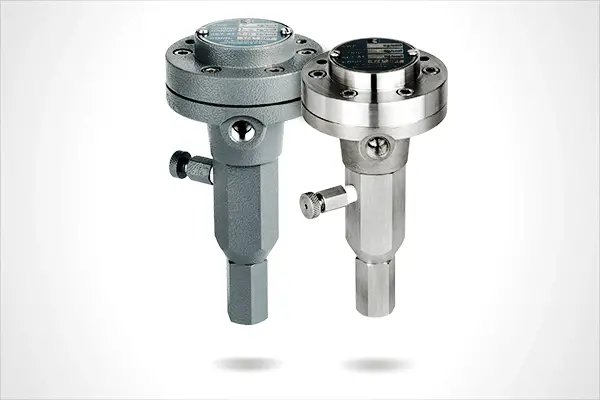Air Lock Relay is designed such that when the header / supply air pressure falls below the desired set value (cut-off value) the Air Lock traps the air pressure in the diaphragm chamber of the actuator.
Air Lock is used when it is required to automatically hold the air pressure in control valve diaphragm chamber of the actuator, in an event of failure of air supply.
When supply pressure drops below a preset value, the Air Lock Relay locks the air pressure in the diaphragm chamber of the actuator thereby holding the control valve in the same position, till the air supply is resumed.

The pneumatic lock-up valve or air lock relay shuts off the signal pressure line either when the air supply falls below an adjusted value or upon complete air supply failure. This causes the pneumatic actuator to remain in its last position.
The supply air produces a force on the diaphragm (4) which is balanced by the spring (6). When the force produced on the diaphragm is greater than the spring force, input and output are connected, i.e. the signal pressure supplied by the positioner is transmitted unobstructed to the pneumatic actuator.
When the supply air pressure falls below the adjusted value, the spring force dominates, and the spring (6) moves the plug (3) fully into the seat (9). As a result, the pressure in the pneumatic actuator is blocked.
Image Courtesy : Samson
The cut-off is sat to a desired value by compressing the spring by spring adjusting screw. If the actuator pressure range is 0.2-1.0 Kg/cm², the setting of this relay could be much higher than 1.0 Kg/cm² as desired for cut off. Where many control loops are involved, the setting of this relay therefore needs impulse connection for cut off from the air supply header.
Cut off setting has been factory adjusted to the desired cut off value. Should it be required to re-adjust the cut off setting, this could be achieved either while the unit is already installed and connected to the system or separately on the test bench. Inlet supply air and the outlet output gauge should be available to re-adjust the setting.
To adjust the cut off setting, remove cap and adjust spring adjusting screw until desired outlet cut off pressure is achieved. Please note that air lock pressure differential is approx. 0.17 Kg/cm² higher than the set cut off pressure.
Turning the adjusting screw clock-wise will increase the cut off setting and turning anti-clockwise will reduce the cut off setting.
In this relay, a built-in manual relief valve is provided if the control valve has manual hand wheel. This exhausts the air from the diaphragm chamber when the hand wheel is operated to avoid damage to the actuator diaphragm.
Replace cap securely after having re-adjusting the cut off setting.
Parts :
Source : Samson
Lube oil consoles of rotary equipment packages in industrial process plants are usually equipped with…
Rotating equipment packages such as pumps, compressors, turbines need the lube oil consoles for their…
This article explains how to blink lights in ladder logic with a detailed explanation video…
In this article, a simple example will teach you the conversion from Boolean algebra to…
In this article, you will learn the PLC cooking timer example for kitchen automation using…
Learn an example PLC program to control a pump based on level sensors using ladder…
View Comments
please sir help me to save the document
Step by Step Procedure sent to your email. Please check.
Dear sir
This is venkataramana from Kuwait KNPC we have a problem for flow control valve air fail to lock ,when air fail valve not lock on desire value it's getting close. set the cut-off and relay screw adjusted but not stay air in actuator chamber, can you please solve my problem, functioning not good.
You can use airlock relay between positioner to actuator tubing so that at air fail condition if the air lock relay is working it will hold the pressure in the actuator and the valve position will remain undisturbed.
Apart from Relieving type is there built in relief to over pressurization in Air Filter/Regulator.
If Air Lock relay fails in any condition then will it be stayput or it will release air?
Good day Instrument Engineers and SMEs, I have a question, My question is about a ring and Pinion Bettis Actuator Installed with a ball Ball Valve and also a Bettis Series G Actuator Installed with Ball Valve, Air is Supplied to these actuators and the Supply line for air is Isolated and the systems were commissioning for Process gas to flow via the Pipe Headers how long can the actuator and Valve keep being in open Position without a dedicated air supply, as the actuator configurations are Fail to close.
In practice in an oil and gas flow station, it is a must for a dedicated air supply via an air compressor, but in this case, the project design engineer for SPDC is introducing this methodology using Nitrogen supply to open and the valves and lockout the supply from the nitrogen via ball valve installed in the tubing's lines to the Valves. please I need urgent answers
Dear Sir
How to check pop-up for PSV relief valve. Please let me know.